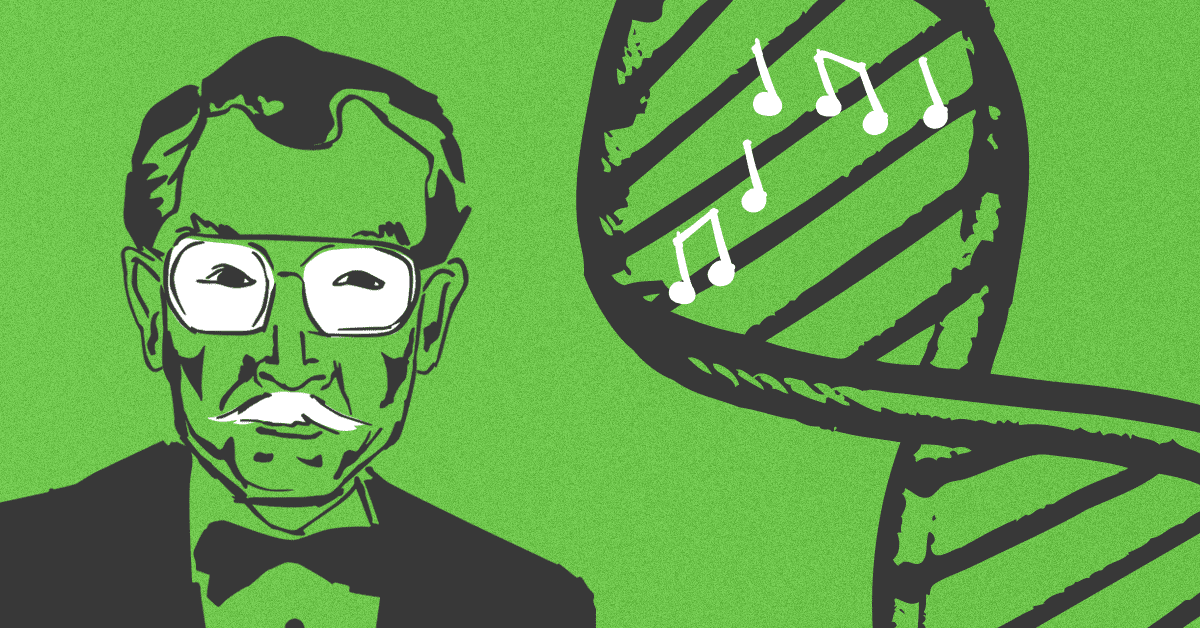Dr. Susumu Ohno: Finding the beauty in DNA

We’re celebrating Asian American and Pacific Islander Heritage Month by shining a spotlight on scientists whose work changed the world. These scientists share a common heritage that traces back to Asia or the Pacific Islands, but they share more than that—each of them had a passion for science that drove them to make history. Join us as we celebrate these figures all month long.
It’s an unfortunate reality that science is often viewed as being separate and independent from art. In principle, the two are diametrically opposed: Science is an empirical practice that’s necessarily detached from emotion and personal bias, whereas art is inherently personal and allows for the creative expression of individual viewpoints. Despite their differences, the two find common ground in their ability to uncover beauty in nature. This commonality shines through in the amazing work of Dr. Susumu Ohno, who fused art with theoretical biology and genetics to change the way we view human evolution.
For much of his career, Dr. Ohno was focused on trying to understand the function and evolution of sex chromosomes. Chromosomes are the microscopic structures that contain DNA and proteins. Humans have 46 chromosomes, which represent two sets of 23 chromosomes—one set inherited from each parent. Most of the chromosomes in a set have a nearly identical copy in the other set which has all the same genes. In this way, you inherit two copies of chromosome 1, two copies of chromosome 2, and so on.
This holds true for all of our chromosomes except for the sex chromosomes. The sex chromosomes are a pair of chromosomes that help determine a person’s biological sex and—importantly—do not always carry the same genes. Someone who is biologically female will inherit two X chromosomes, and someone who is biologically male will inherit one X chromosome and one Y chromosome. Because the X and Y chromosomes have different genes, an XY individual will develop differently from an XX individual who has twice the amount of X chromosome genes and no Y chromosome genes.
In the 1950s, geneticists were faced with a significant question relating to sex chromosomes: Why doesn’t a person who inherits two X chromosomes show twice as much X chromosome gene expression? This is when Dr. Ohno made his first big discovery.
Dr. Ohno was a cytologist, which means he studied cells and everything inside cells (including chromosomes). Based on observations made using just his microscope and evidence from elsewhere in the field, Dr. Ohno put forth the idea that cells could compensate for the double dose of X chromosome by shutting one of them off in a process known as X-inactivation1. His work, combined with that of Dr. Mary Lyon in the UK, would eventually demonstrate that one copy of the X chromosome becomes inactivated in every cell of a biological female, which can affect their traits. These insights provided a foundational understanding of sex chromosome properties and has helped us understand how various traits and diseases are influenced by this process1,2.
They showed how DNA could be translated into music and vice versa
Later in his career, Dr. Ohno transitioned into studying evolution through theoretical biology3. In this field, he had a truly revolutionary insight that the duplication of genes and entire genomes was a critical force in evolution. His theory suggested that the accidental duplication of a gene could be helpful because mutations in that gene wouldn’t be as problematic, since the cell had another copy. With this flexibility, duplicate genes could accumulate changes in their DNA sequence and potentially take on new functions. This is similar to having two rooms in a house instead of one. If you have two rooms, you’re free to turn one of them into a living room because you already have a bedroom. In the same way, Dr. Ohno suggested that repetition in the genome was critical to advancing the evolution of complex lifeforms. This notion has gained considerable attention in the past decade and is still a topic of ongoing investigation3.
Dr. Ohno believed that the evolution of complex life through introduction of repetitive sequences in the genome was similar to the evolution of complex musical scores. To show this, he worked with his wife Midori Ohno to publish a beautifully written article comparing the repetition in DNA with the overlapping, repetitive melodies in music4. In this paper, they showed how DNA could be translated into music and vice versa. For them, studying the evolution of melody and sound in music was more than an artistic endeavor, it was a theoretical exploration of how genetic complexity may have evolved in similar ways. For the rest of us, Dr. Ohno’s work helped reveal the incredible art that lies within our DNA.
1Beutler, E. “Susumu Ohno: the Father of X-Inactivation.” Advances in Pediatrics., U.S. National Library of Medicine, www.ncbi.nlm.nih.gov/pubmed/9678326.
2Wolf, U. “Susumu Ohno.” Advances in Pediatrics., U.S. National Library of Medicine, www.ncbi.nlm.nih.gov/pubmed/9678324.
3Meyer, A, and Y Van. “’Natural Selection Merely Modified While Redundancy Created’–Susumu Ohno’s Idea of the Evolutionary Importance of Gene and Genome Duplications.” Advances in Pediatrics., U.S. National Library of Medicine, www.ncbi.nlm.nih.gov/pubmed/12836679.
4Ohno, Susumu, and Midori Ohno. “The All Pervasive Principle of Repetitious Recurrence Governs Not Only Coding Sequence Construction but Also Human Endeavor in Musical Composition.” Immunogenetics, vol. 24, no. 2, 1986, pp. 71–78., doi:10.1007/bf00373112.